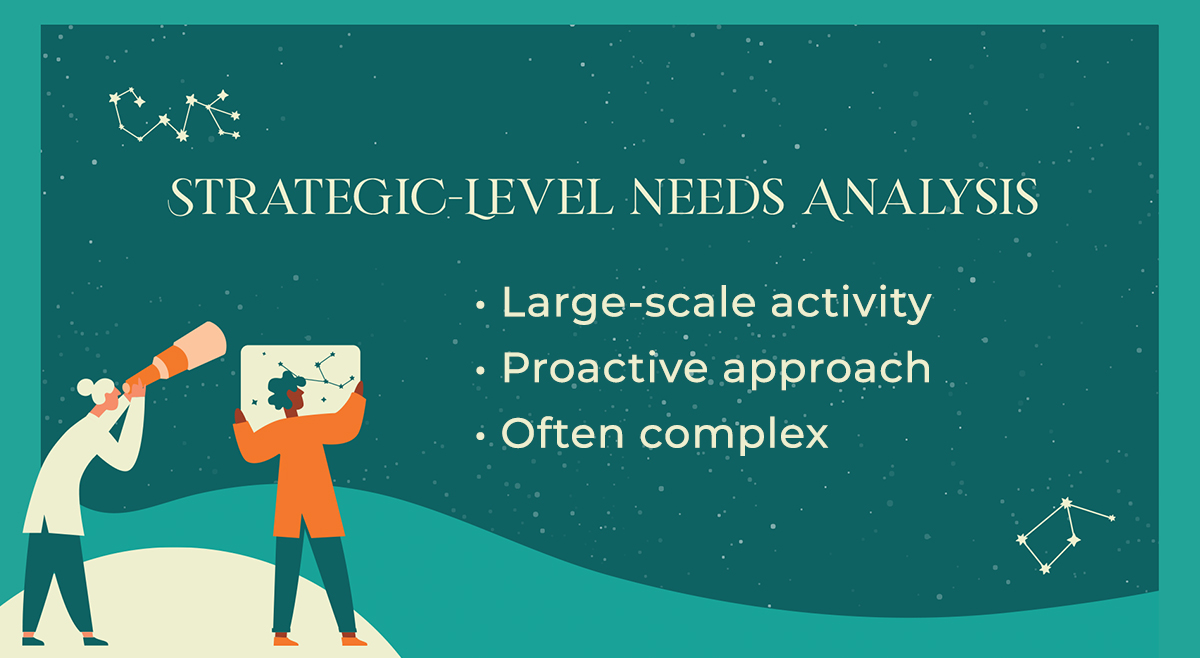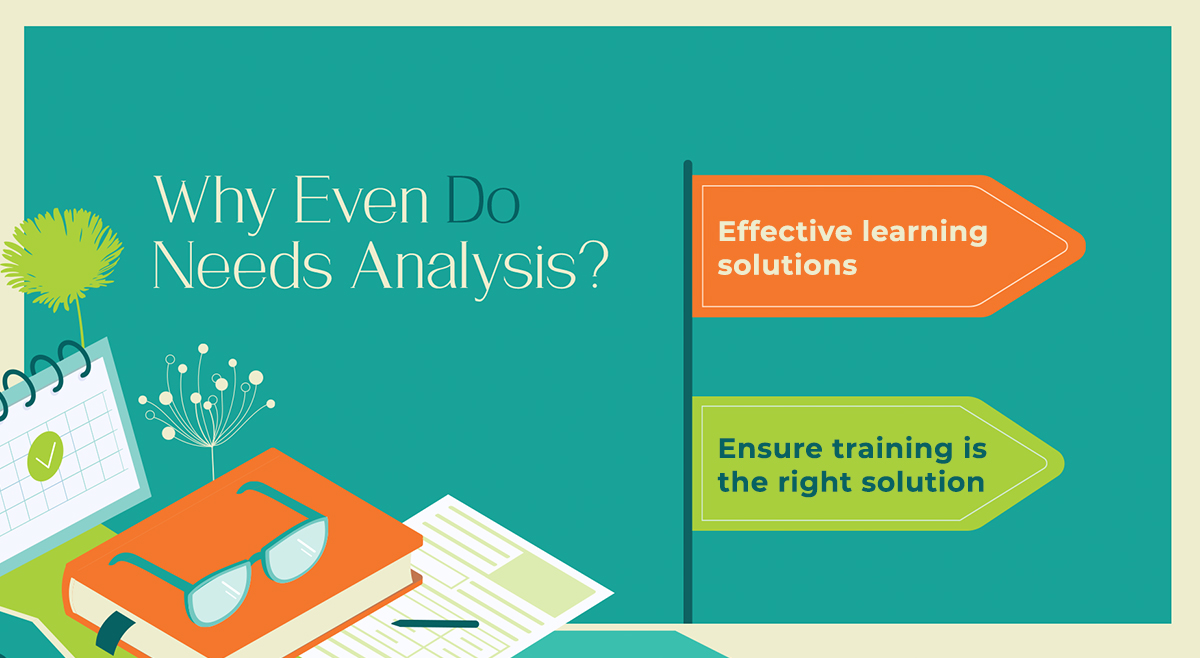An insider’s look at leading-edge learning innovation at Hilton
We’re entering our second year of generative AI buzz, but organizations are just beginning to scratch the surface, with most using the technology to create first drafts, identify data patterns, and summarize lengthy texts. Meanwhile, they’re leaving nuanced human pursuits like critical thinking, creativity, relationship building, ethics, and navigating complex and ambiguous situations to…well, their humans.
Training is another pursuit that’s been left to humans: None of the 1,600+ respondents to a global survey on the state of generative AI called out training as a use case.
This vast, virtually untapped opportunity is what makes generative AI so exciting for L&D innovators—like our friends at Hilton. Read on to discover how the Hilton-SweetRush team set out on an exploratory mission into the heart of generative AI… and emerged with a leading-edge immersive learning experience.
Generative AI: Hilton’s L&D Use Case
With a robust portfolio of effective, engaging WebXR and native VR learning solutions, the Hilton-SweetRush team were already veteran immersive learning creators. Amazing experiences such as Hotel Immersion and Exceed with Empathy (see below) place learners in someone else’s shoes—and drop them into interactive, day-in-the-life scenarios that help them gain insight and empathy.
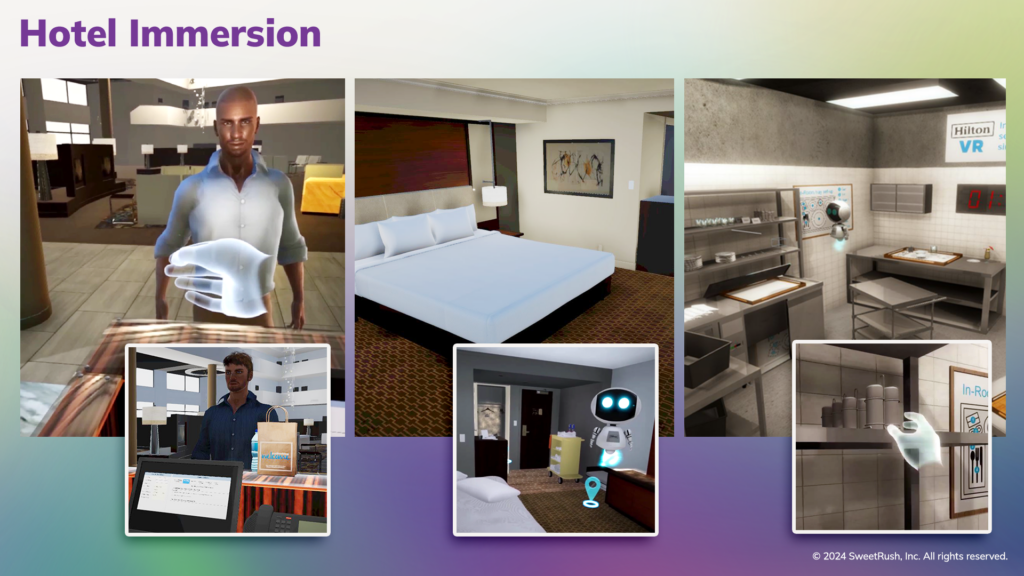 ‘
‘Learner Audience: Newly hired team members
Purpose: Help learners gain empathy for hotel operations team members.
The Experience: The Hilton-SweetRush team wanted newly hired team members to experience a day in the life of the hotel operations team members who drive results via brand standards. In this energetic simulation, learners land in a Hilton hotel—and work against the clock to assemble room-service trays, clean a guest room, and check guests in at the front desk. Learners access this experience via a headset, which gives them the freedom to move around and interact with objects in these 3D spaces.
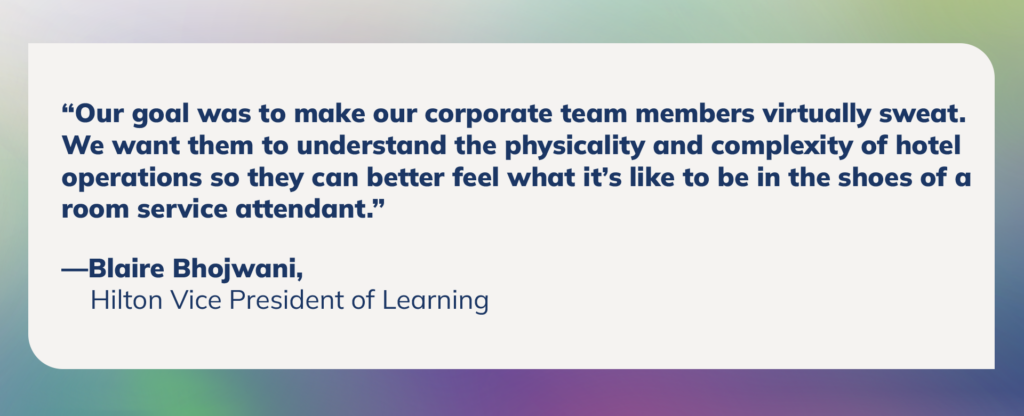

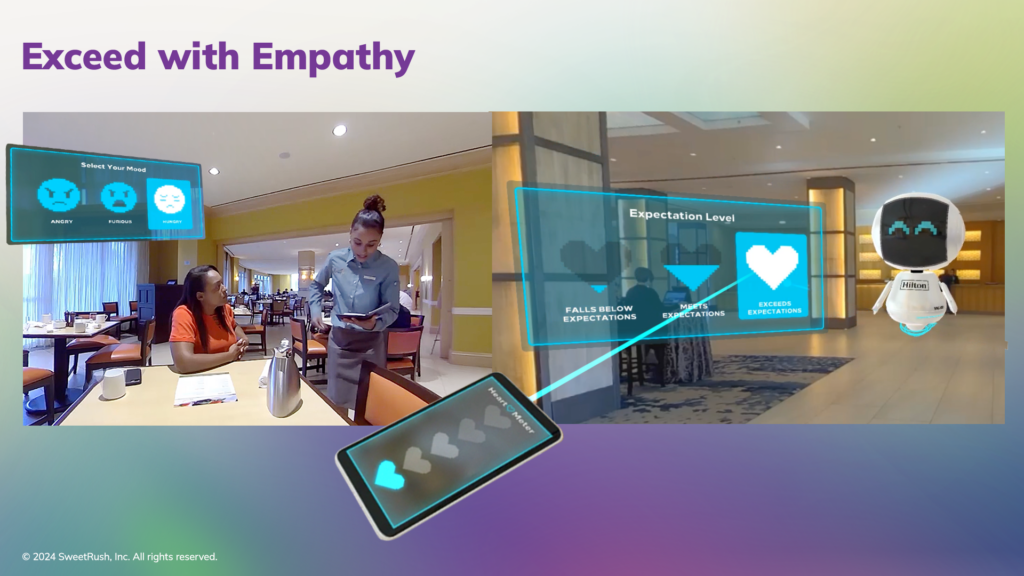
Learner Audience: Hotel operations team members
Purpose: Help learners develop empathy for guests.
The Experience: Learners step into the shoes of a guest waiting in a long line to check in, after hours of travel; a guest who’s served the wrong order at the restaurant; and another who finds that the conference room they’ve booked is improperly set up. After each experience, they reflect on their mood, gain greater insight into the guest experience, and discover how to exceed guest expectations.

In spring 2023, the team began to wonder how they might leverage generative AI to take Hilton’s immersive learning game up a notch. The timing was right, and so was the learning need: Create an engaging, effective, and scalable immersive experience to help hotel operations staff practice their guest service skills.
Read on for background about the business and learning needs—and how the team met them with creativity, ingenuity, and industry-first technology.
Hilton’s Business Need: Deliver a Reliable and Friendly Stay
Guest feedback shared the wish for a reliable, consistent, and friendly stay, where team members treat every guest like a friend. Thus the powerful impetus for Hilton’s leading-edge guest service skills training was born.
This impactful learning journey, called Make It Right, features a variety of bite-sized eLearning modules, pre-shift team meetings, videos and more.
One part of Make It Right focuses on service recovery with HEART, Hilton’s five-step problem-resolution model (see below).


At this stage in the learning journey, Hilton team members are equipped with a good understanding of HEART. But knowing the five steps and their purpose and putting them into practice—especially under pressure—are two different things.
Like so many interpersonal skills, service recovery requires plenty of trial, error, and feedback before learners achieve competency. While role-plays are one way to achieve this, Hilton chose a virtual environment to build confidence with their teams during their training process.
Would this catch-22 derail the opportunity for hands-on practice of the HEART model? Not for the Hilton-SweetRush team!
WebXR and Generative AI: Scalable Immersive Learning for Hilton’s Global Audience
The Hilton-SweetRush team rose to the challenge by creating a capstone experience that brought hands-on HEART practice to team members across all its hotels.
How? By leveraging WebXR, a super-scalable virtual reality learning technology.
Because WebXR content lives on a web browser and can be accessed by learners with or without a headset, it’s an ideal modality to bring the benefits of virtual learning to a distributed global audience like Hilton’s.

Helping Hilton team members speak from the heart was the perfect learning use case for WebXR. To practice these vital service recovery skills, they created the Delivering on Our Customer Promise experience. This WebXR- and AI-powered simulation drops learners into three different scenarios with concerned guests, each of whom explains their problem and waits expectantly for a response.
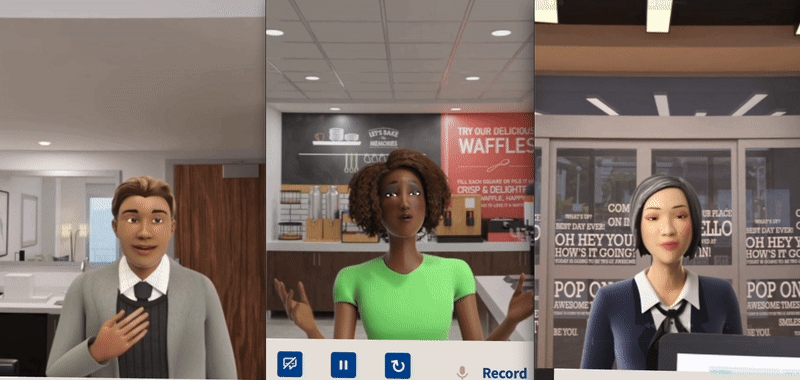
These scenarios make learners sweat a little, just as real service recovery situations do. Yet rather than risk real relationships with Hilton guests, they find their feet—and voices—within a safe, authentic virtual practice space.
Generative AI: Hilton’s High-Tech Human Skills Coach
Hilton’s Delivering on Our Customer Promise WebXR adventure was already a leading-edge learning experience—but the team’s addition of generative AI lands it among L&D industry firsts.
Here’s how generative AI helps learners make it right: After listening to the guest explain their problem, learners speak their response into their device’s microphone, using the HEART steps they’ve learned.
The simulation records their response, converts it into text, and feeds the text of the response into a Large Language Model (LLM). On the back end, the LLM, which has been carefully “trained” by SweetRush SMEs, creates a response to the learner’s attempt. (Discover how SweetRush’s exacting SMEs systematically trained the LLM to evaluate learner input and deliver relevant, actionable feedback.)
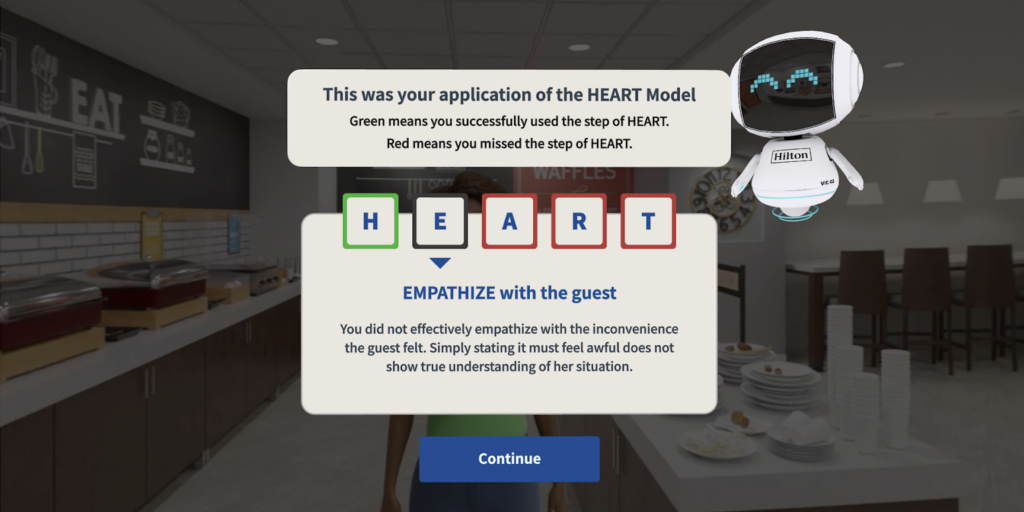
After completing each scenario, learners can then reattempt it as many times as they like, receiving targeted feedback each time.
Learner Experience (LX): Designed by Experts, Hosted by VIC
To create the greatest impact, the team focused the WebXR experience on three different scenarios, all based on top guest problems:
- Room climate controls
- Food and beverage options
- Special room requests not met
Using their best storytelling and dialogue-writing practices, the team built branching scenarios featuring a guest interaction in different areas of the hotel. These in-room, front-desk, and breakfast-area conversations could end with positive, negative, or neutral results based upon the learner’s input.
The instructional designer worked closely with Hilton SMEs to craft realistic guest scenarios—and responses that matched Hilton’s high standards and signature service recovery methods.
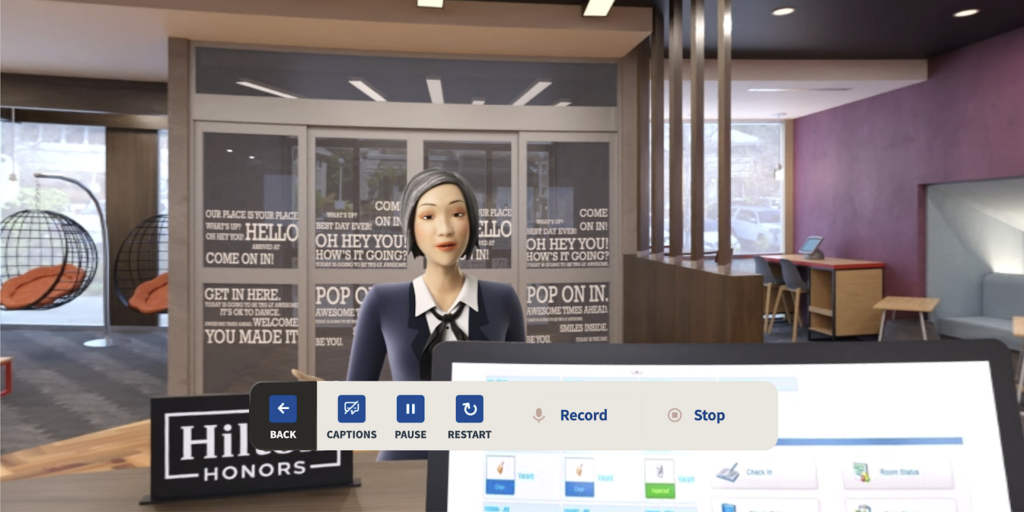
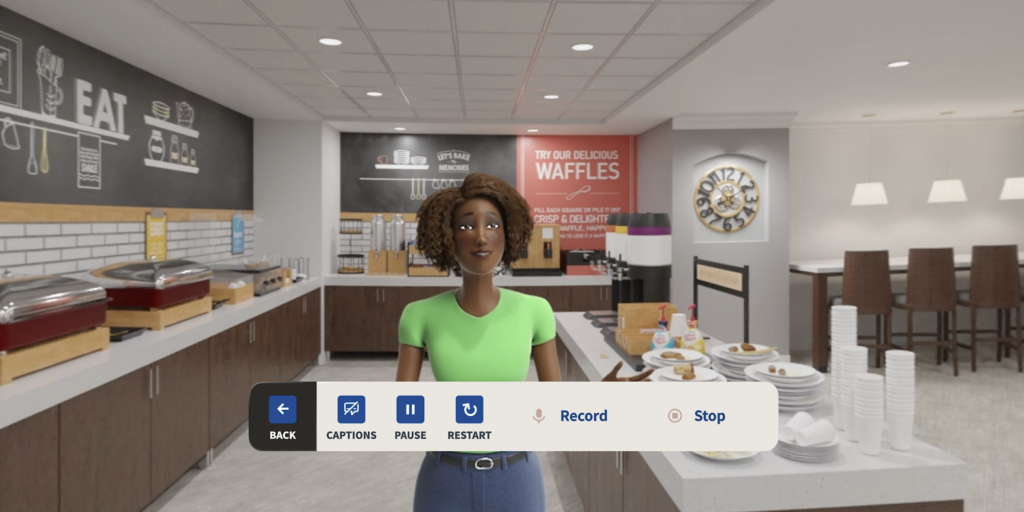

Making It Look, Sound, and Feel Right: Designing in 3D
Appearance matters for a 360° immersive experience, and a realistic setting is an important part of creating an authentic immersive scenario. The team custom-created these lifelike settings by taking photographs at real Hilton properties—and the SweetRush extended reality (XR) team built depth and detail into each scene.
The guests’ avatars needed to be as diverse and expressive as Hilton’s guests are in real life, with the tone of voice, gestures, facial expressions, and posture that reflects their mood and level of satisfaction.
Why this painstaking care? To truly immerse learners, they need to feel that they’re face to face with a real guest in a real Hilton hotel.
Because of the complexity of the scenarios and their different potential outcomes, the creative director, instructional designer, and XR team worked closely together to ensure that the content, audio, and visual treatment informed one another.
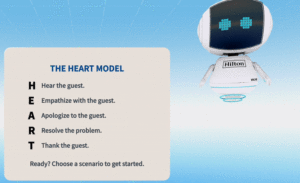
Like any great guest experience, the HEART model training experience needed a great host who would encourage learners and serve as their guide throughout all three scenarios. VIC, Hilton’s friendly robot emcee (and breakout star of previous VR experiences), was up to the task, hovering in the scene with helpful instructions, a HEART walkthrough, and learner feedback. (Join us for a demo of this leading-edge immersive AI coaching experience at Training Industry’s Leader Talk: Using AI to Transform Content Development.)
Leading-Edge Learning at Your Organization: Leverage Generative AI Coaching and Immersive Training for Your Unique Needs
Feeling inspired by Hilton’s generative AI-powered, immersive learning VICtory? We’re with you!
We’ve loved sharing the story of how one innovative client-partner leveraged the leading-edge powers of WebXR and generative AI to meet Hilton’s deeply human business need: a warm welcome and friendly stay for every guest.
If you’re curious about how to apply WebXR and generative AI to your organization’s unique needs and learners, we’ve got you covered!
